
Ryegrass infestations still persist in some fields. In cotton and soybeans, clethodim can be used now to push this weed on to maturity. In corn, other than just going out and spraying the typical POST corn premix and hoping that pushes the ryegrass on to maturity there is no real solution to controlling it.
Thinking ahead to 2024 we have to change management tactics on ryegrass to have a better chance at success in controlling this weed. Research from Jason Bond at Mississippi State would recommend that a November application of residual herbicides like Dual Magnum, Boundary or Zidua can provide a lot of help controlling ryegrass the next spring. This would be a good fit for some of our fields that are in river bottoms and fields where erosion is less of a concern.
On all of Tennessee rolling hill farms, some winter annual weeds can be helpful holding the field in place. In those cases, applications of clethodim in February or early March would likely be a better management tactic for ryegrass. What should be avoided is April and May applications of glyphosate and/or clethodim as they are clearly not working. Ryegrass that close to natural maturity is not affected much by these herbicides.
Johnsongrass is also a consistent problem in a good many cornfields. Glyphosate is just not providing any traction in the burndown on Johnsongrass and the POST in-crop applications are no better. Our most recent research has shown that Steadfast Q or Accent Q can still provide good control of Johnsongrass when glyphosate fails. Thank you to the Tennessee Corn Growers Association for supporting this research.

